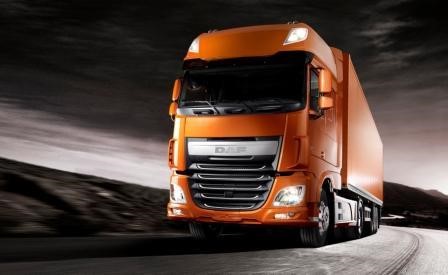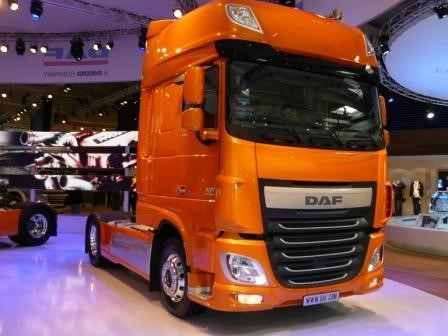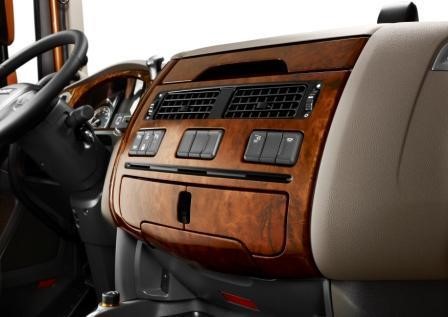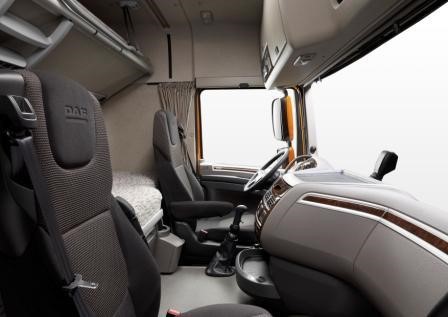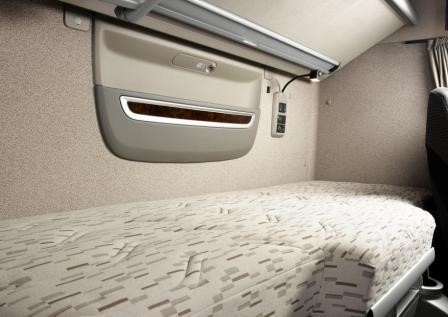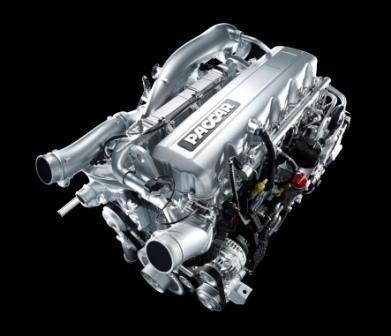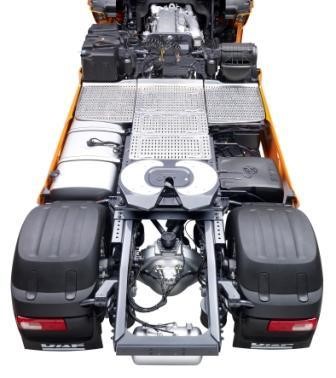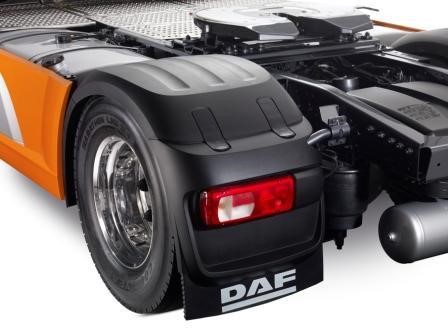Euro 6 DAF XF All the Facts and Figures
DAF took its time to ensure that it meets the Euro 6 requirements in the best way possible, they kept the cab but changed most other things:
New Euro 6 PACCAR MX-13 engines:
- Design life of 1.6 million kilometres
- Fuel consumption at low Euro 5 ATe level
- Maximum performance: up to 2,500 Nm torque at low engine speeds
Optimised on weight for maximum payload
- Increase in the total weight of the new Euro 6 limited to < 90 kg
Completely new chassis
- Smart component layout
- Fuel tank capacity up to 1,500 litres
- New cab and axle suspension for excellent vehicle stability
Low operating costs
- Service intervals up to 150,000 km
- Focus on low vulnerability
- Many new ATe solutions, including:
- Excellent cooling and optimized air flow
- "PACCAR by ZF" AS-Tronic gearboxes with EcoRoll and Fast Shift
- New rear axle and new gear ratios
- Driver Performance Assistant as standard on all versions
The new PACCAR MX-13 Euro 6 engine can be supplied with outputs of 300 kW/410 hp, 340 kW/460 hp and 375 kW/510 hp with high torque outputs from 2,000 to 2,500 Nm, available across a broad engine speed range (1,000-1,425 rpm). A key principle when developing the new driveline was to keep fuel consumption at the same low level as that of the current Euro 5 ATe engines, without compromising durability (design life of 1.6 million kilometres) and vehicle availability (service intervals up to 150,000 km).
The Euro 6 PACCAR MX engines are linked to redesigned manual and automated 12 and 16-speed PACCAR gearboxes, produced by ZF. The new functionalities of the automated transmissions include EcoRoll and Fast Shift, which improve driving comfort and further reduce fuel consumption and CO2 emissions. The same applies to the new rear axles that have new, longer final-drive ratios for lower engine speeds.
Optimised weight for high load capacities
Euro 6 emissions legislation means a considerable amount of additional technology is necessary #&8211; adding extra weight. New chassis layouts and smart solutions have been used to minimise any additional weight as far as possible, keeping payloads high and fuel consumption low.A new, even lighter rear axle is available for combination weights of up to 44 tonnes and engine torques of up to 2,300 Nm. A Stabilink structure that incorporates the function of the anti-roll bar is used in the suspension to reduce weight and provide a high level of stability and excellent handling. A new fifth wheel mounting plate and the clever way in which the battery boxes have been mounted also result in weight savings. The new steering gear is mounted on a multifunctional casting, eliminating the need for a separate steering box mounting. There are numerous other examples of ways in which the weight of the new XF has been optimized, including the new roof spoiler. The end result of all of these measures is that a standard Euro 6 XF 4x2 tractor is a mere 90 kilograms heavier in total than the equivalent Euro 5 XF105
Targeting maximum efficiency, DAF focused on providing the best possible layout for the completely new chassis. The standard 90-litre AdBlue tank (140-litre tank optional) is positioned under the cab and the batteries can be positioned to the rear inside the chassis. Combining the DeNOx system and the soot filter into a single unit makes it possible to provide fuel tank capacities of up to 1,500 litres for a maximum operating radius, beneficial where fuel prices are at their lowest.
DAF has also taken a number of additional measures to reduce vulnerability, further optimising vehicle availability and efficiency. Examples include unbreakable Lexan headlight and fog light covers, a new galvanised steel bumper, a new rear mudguards and a redesigned closing cross-member for the chassis.
Advanced Transport Efficiency
With the new XF, DAF is introducing a number of innovations that tie-in perfectly with the Advanced Transport Efficiency (ATe) programme, which aims to lower operating costs and reduce environmental impact. Examples include the optimised cooling system, which means that the fan is required less often, the new functionalities of the 'PACCAR by ZF' gearboxes, the new rear axle ratios and the use of soft cruise control, which gradually returns the vehicle to the previously set speed.The Driver Performance Assistant is another excellent example of DAF's ATe philosophy. The central display on the dashboard provides the driver with detailed information on how much fuel is being consumed, levels of driver anticipation and braking behaviour. In addition, messages appear automatically on the information screen that can assist even more in driving efficiently, for example by recommending the driver to shift to a higher gear. The central display provides tips on how the driver can save fuel and operating costs by ensuring correct tyre pressure and spoiler position. The driver's attention is also drawn to the importance of timely switching off the air conditioning and not allowing the engine to idle unnecessarily.
The new XF: Driver focused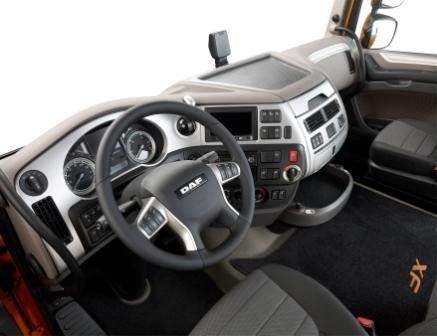
Developed for maximum driver comfortNew seats, a new steering wheel, a new dashboard with a new display and new switches and cup holders for the best work environment
Unequalled interior space for market-leading comfort
Even larger beds for the highest level of sleeping comfort
Safety and comfort
o Door windows out of one piece
o Larger mirrors and field of vision
o Vehicle Stability Control (VSC)
o Advanced Emergency Braking System
o Energy-absorbing cab suspension
o Excellent driving performance and stability thanks to new axle and cab suspension
Best for the driver
High levels of driver comfort start the moment you step inside the new XF. By cleverly installing the engine and cooling system in the chassis, the height of the cab floor has remained virtually the same, increasing by just only 3 centimetres to 1.47 comfortable meters. This ensures excellent accessibility through only three aluminium steps, which are now positioned in a 'staircase' style. The low cab floor makes the XF Super Space Cab the most spacious cab on the market with a total volume of no less than 12.6 m3. The low cab floor also contributes to the excellent field of vision.
The interior of the XF features a large number of enhancements. New seats offering a very wide adjustment range provide an even greater degree of comfort. The position of the pedals has been revised to include a hanging brake pedal for maximum ease of operation and more foot-well space.
The steering wheel has been redesigned, along with the central information panel on the dashboard, which features new functionalities and a new TFT colour screen. The large screen has a high clarity, making it very easy to read. The instrument panel has been redesigned with attractive aluminium accents around the dials. New, highly visible switches, which have been re-grouped by function, make the controls easy to operate. Other new additions include the two cup holders fitted in the central part of the dashboard, and even a waste bin adjacent to the driver. The door panels have also been redesigned. Optionally these can be fitted with aluminium inlay, which is also used on the co-driver's side of the dashboard. DAF has improved on the market-leading levels of sleeping comfort in its cabs by extending the bottom mattress (160 mm deep) to 2.20 metres. A new multifunctional panel with lighting and storage space is also located on the rear wall.
Comfortable and safe
When developing the new DAF XF, another major focus was maximum safety. That is why the door windows are produced out of one piece. Even the mirror configuration is carefully considered: space has deliberately been created between the main and the wide view mirror to maintain a clear forward view, creating even larger fields of vision. The wide view mirror has a larger surface area and the mirrors on the co-driver's side have been re-positioned further back, creating additional space between the cab's A-pillar and the mirror housing, in order to further reduce blind spots.
Vehicle Stability Control (VSC), which helps to prevent jack-knifing and roll-over, comes as standard. Adaptive Cruise Control (ACC) and Forward Collision Warning (FCW) are optional. Later in 2013 Advanced Emergency Braking System (AEBS) will become available. This system brakes the vehicle independently from the driver and completely, if necessary in an emergency situation. The dashboard is equipped with shock-absorbing zones to prevent injury, for example to the knees , in the event of a collision.
The new, energy-absorbing cab suspension also plays an important role when it comes to safety, as well as the reinforced cab structure with pre-programmed front and rear crumple zones. The suspension has been designed in such a way that the cab remains attached to the chassis in the event of a head-on collision, but is pushed backwards, allowing the cab to remain more intact.
New exterior design: Practical
Sturdy and elegant exterior thanks to new lower and upper grilles and striking chrome panel with DAF logo
Optimised air flows for cooling and low fuel consumption
New galvanised steel bumper
Completely redesigned lighting
New headlight units with LED lighting: a truck industry first
Daytime running lights (LED) and cornering lights
New mudguards, side fenders, side skirts and roof spoiler
DAF's new flagship model has a sturdy appearance, thanks to its completely redesigned front with a smooth, attractive transition between the top and bottom sections. The prominent grille with aluminium accents makes a significant contribution to optimising air flows for both aerodynamics and engine cooling, in order to achieve as low a fuel consumption as possible.
The bumper has also been designed in such a way that it contributes to the truck's aerodynamics and engine cooling #&8211; and it is, of course, made from galvanised steel to reduce vulnerability.
The enlarged nameplate and the chrome panel with DAF logo located under the windscreen are particularly striking, along with the new headlight units. DAF is the first in the industry to offer LED technology (optional) for impressive light output and extra safety, as well as a long service life and lower energy consumption. Also new are the 'cornering lights' that shine into bends in the direction of travel and reduce the risk of damage. Daytime running lights (LED) ensure extra visibility during the day.
Aerodynamics is also a key focus of the new design, including the addition of new developed side skirts, fenders, mudguards and the new roof spoiler for the XF Space Cab. The height of the spoiler can be adjusted quickly and easily by the driver. Mudguards and fenders have been completely redesigned, along with the deflectors on both corners of the front of the cab which guide the airflow to keep mirrors and door handles clean.
With the new XF, DAF is building on the market leading reputation of the XF105, a truck that is highly valued among both transport operators and drivers. The new XF sets the new Euro 6 benchmark in terms of efficiency with the new drive line and the completely new, smart chassis design and with the many other enhancements that have been made to reduce weight. At the same time, driver comfort has been elevated once again with the new cab interior, ride and handling improvements, first class driving performance, and a higher level of safety.
XF Cab Highlights
- New exterior design is attractive, functional and well thought out
- Refined design, optimised aerodynamics and an excellent cooling system for economical fuel consumption
- Front grille with aluminium accents, prominent chrome panel with DAF logo, new bumper
- New headlight units with LED technology, a first in the truck industry
- New mudguards, new side skirts, new fenders with new air inlets, new roof spoiler with unique adjustment range
- New interior design
- Unsurpassed spaciousness, both living and storage space
- Further improved working and sleeping comfort as a result of new seats and an even bigger bed
- New dashboard for optimised ergonomics and an even greater ease of operation
- TFT information display with DAF Driver Performance Assistant
When developing the new XF, DAF continued to build on its much admired cab concept, which is renowned for its spaciousness and practical comfort. A completely redesigned front #&8211; together with the new mud guards, fenders and side skirts #&8211; ensure a very modern appearance. In addition, maximum attention was paid to aerodynamics and optimising air flows for cooling, resulting in better fuel economy The new headlights with LED lighting, a first in the truck industry, also contribute to this saving. The new XF offers the driver an even better working, resting and sleeping environment, thanks in part to a completely new dashboard arrangement, new seats, an even bigger bed and numerous new, practical storage solutions.
What first catches the eye on the new DAF XF is its new exterior design. The front has a refined design which beautifully integrates the top and the bottom of the truck's front. What is striking is the large, matte black grille with aluminium accents and a central, chrome panel bearing the DAF logo, which lends it a bold yet elegant appearance. The beautifully styled headlights also contribute, and the newly designed, galvanised steel bumper with integrated air guides contribute to better engine cooling.
The new headlight units come with H7 halogen lighting with integrated Day Time Running Lights (4 LEDs) as standard for excellent visibility during the day. LED headlight technology is optional for the headlights on the new XF#&8211;a first in the truck industry. LED lighting guarantees the greatest light output with a maximum service life and minimum energy consumption. Combined with this innovative LED technology, optional headlamp washers are also available, beautifully integrated in the new light units.
Another new addition are the "Cornering Lights". These are attractively designed as part of the new steel bumper and are combined with fog lighting. Cornering Lights are illuminated when manoeuvring and turning in the driving direction and provide increased comfort and safety and a reduced risk of damage. With a view to keeping susceptibility to damage at an absolute minimum, the covers of the headlights and the fog lamps are made of unbreakable Lexan.
All of the lamps in the new front of the truck have excellent accessibility by way of inspection panels. This means, for example, that the headlight bulbs can be replaced quickly and easily without having to tilt the cab.
Well-designed roof spoiler
When designing the new XF, DAF paid much attention to optimising the air flow reducing air resistance and also minimising dirt and spray. The newly designed cab corner deflectors at the front of the truck direct the air flow in such a way that the door handles remain clean. Two of the three cab steps are protected by the door, also with the aim of combating dirt and reducing air resistance.Because the width of the vehicle has increased to 2.55 metres, the mudguards, side fenders and side skirts have also been redesigned with a view to optimising aerodynamics and reducing dirt build up. The skirts with integrated steps have also been moved more towards the front. A side indicator has also been integrated into the mudguards to facilitate more awareness for cyclists and pedestrians
Another new feature for the Space Cab is the roof spoiler, which reduces weight by approximately 25 kilogrammes. A unique addition to the new XF is the optional mechanism that the driver can use to easily and comfortably adjust the height of the spoiler using a spindle while standing next to the truck. A spoiler adjustment, perfectly matched to the trailer in all circumstances improves fuel consumption.
A windscreen cleaning set is also supplied as standard. This contains an ice scraper, a wiper and a cleaning cloth that is attached to a long telescopic arm which allows the driver to clean the windscreen easily and effectively.
Maximum boarding comfort
In spite of the substantially larger radiator, the cab floor remains at a similar height , increasing by just three centimetres, resulting in an overall height of just 1.47 metres. This ensures easy cab entry and exit with only three aluminium steps, which are now placed more in staircase style rather than one directly above the other, as previously. As a result of the low cab floor, even with a maximum interior height of 2.25 metres for the Super Space Cab models, there is space to fit flashing lights or an air horn, even with large tire sizes such as those used with heavier 9-tonne front axles.Optimum cab layout
DAF has consciously chosen to maintain the XF105 cab concept. After all, the starting point was that no concessions could be made on the class leading interior space and the comfortable accommodation. With a total volume of 12.6 m3, the XF Super Space Cab remains the most spacious cab in its class, and the interior height of 2.25 metres is unparalleled in the industry. Even when the top bunk is folded down, the driver and any co-driver have all the space they need to move comfortably without interrupting the storage space above the windscreen. Furthermore, the space in the cab is large enough that the use of the beds does not limit the adjustment options of the seats, so that after sleeping, the seating does not have to be readjusted every time.And with a total storage space of approximately 1000 litres, the new XF Super Space Cab sets the standard with three large compartments above the windscreen (with space for a microwave oven) and a plenty of storage space under the bed (675 litres), where a 65 litre drawer can be positioned, or even combined with a 42 litre refrigerator in which even large bottles can be placed upright. A handy waste bin has been added, adjacent to the bottle holder, directly next to the driver's seat.
New seats
Excellent utilisation of the space in the cab has been achieved by paying maximum attention to the most important functions: driving, relaxing and sleeping. First and foremost, the new XF offers every driver an extremely comfortable seating position, thanks to a new generation of seats with superb comfort and ease of operation. The seat can be adjusted 220 millimetres and 145 millimetres in height. As a result, an exceptional number of settings are possible. Also new to the XF is the split back rest at shoulder height and the height adjustment of the integrated safety belts. The seats are attractive, with distinctive upholstery in a warm grey shade and an integrated DAF logo in the headrest. To ensure effective ventilation, the permeability of the materials used was an important factor in the design. At the same time, the distinctive new seats are characterised by their optimal ease of operation with logically positioned, robust handles and buttons. Two-step ventilation and heating are available as at an additional cost, as is complete leather upholstery. Also the driver's seat can be equipped with a quick-release coupling for a small air gun that can be used to blow the cab interior clean.The pedals make a significant contribution to creating an ideal driving position. The new accelerator pedal provides in an even better graduated action thanks to new electronics. In addition, the brake pedal is now a hanging type, creating more space for the driver's feet. The steering wheel can now be tilted smoothly from 30 to 45 degrees and can be adjusted in height by 80 millimetres. It has been completely redesigned with smart chrome accents. The operating units for infotainment (radio and telephone) are located on the left spoke of the steering wheel, while the acceleration-related functions are grouped on the right side (cruise control, downhill speed control and Adaptive Cruise Control). A full leather steering wheel is available as an option.
Climate control
While further optimising the accommodation comfort, much thought was given to first-rate climate control. The cab heater has air vents on both the co-driver's and the driver's sides, as well as in the middle of the cab. This unique feature provides the best possible distribution of the heat across the cab floor. The cab heater also has an extra air vent under the bed to achieve even heat distribution between the fore and rear sections of the cab.The air vents in the newly designed door panels have also been improved for improved demisting and defrosting of the side windows, providing an excellent view of the road, as well as in the mirrors.
The control of the heating and ventilation system has been further improved with regard to operation as well as performance. Still included in the new model, of course, are DAF's well respected double curtains, which can completely black out the cab interior even in the middle of the day, and the electrically operated roof hatch with integrated insect screen and sun blind, which is also operated electrically in the Super Space Cab. The roller blinds on the windscreen and the door windows are also practical, as they prevent glare from the sun. DAF has also developed a smart sun blind that prevents glare between the A-pillar and the windscreen sun visor.
TFT information screen with DAF Driver Performance Assistant
The dashboard has been designed around the driver and is available in three versions with a black finish, or with either Argenta (alu-look) or Rustica (wood-look) deco panels. The dashboard switches have been redesigned and are grouped by function for maximum ease of operation. The instrument panel has been completely renewed. The clocks and gauges with aluminium accents and non-reflective glass are newly designed for a more modern appearance and maximum readability. In the centre on the left is the speedometer, with digital information about speed related functions (cruise control and downhill speed control) at the base. The rev counter, with integrated digital information about the gearbox and the Intarder, if applicable, is located on the right-hand side of the instrument panel.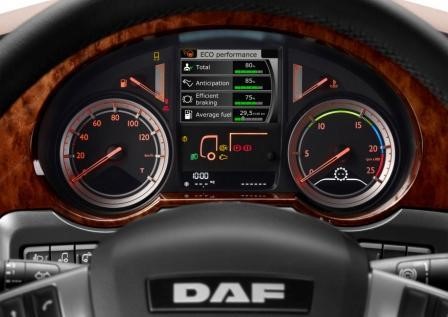 In the centre of the dashboard sits a 5-inch TFT colour display that provides information in 32 languages about all of the vital vehicle and engine functions and which also supports the driver in driving as economically as possible. This display provides detailed information on how much fuel has been used, levels of anticipation whilst driving and braking behavior. Furthermore, automatic messages appear on the information screen which help the driver to drive even more efficiently. For example, DAF Driver Performance Assistant indicates when a higher gear can be selected and compliments the driver whilst driving when he or she has correctly anticipated the driving situation by removing his or her foot from the accelerator pedal succinctly and allowing the vehicle to roll or by making use of the engine brake or Intarder to minimise wear of the foundation brakes. In addition, the central information display provides tips about how the driver can save fuel and operational costs e.g.: by turning off the air conditioning when it is not needed (fuel saving up to 2%), avoiding idling as much as possible (fuel saving up to 1.5 litres per hour), adjusting the spoilers to the correct height and making sure that the tyres are inflated to the correct pressure.
In the centre of the dashboard sits a 5-inch TFT colour display that provides information in 32 languages about all of the vital vehicle and engine functions and which also supports the driver in driving as economically as possible. This display provides detailed information on how much fuel has been used, levels of anticipation whilst driving and braking behavior. Furthermore, automatic messages appear on the information screen which help the driver to drive even more efficiently. For example, DAF Driver Performance Assistant indicates when a higher gear can be selected and compliments the driver whilst driving when he or she has correctly anticipated the driving situation by removing his or her foot from the accelerator pedal succinctly and allowing the vehicle to roll or by making use of the engine brake or Intarder to minimise wear of the foundation brakes. In addition, the central information display provides tips about how the driver can save fuel and operational costs e.g.: by turning off the air conditioning when it is not needed (fuel saving up to 2%), avoiding idling as much as possible (fuel saving up to 1.5 litres per hour), adjusting the spoilers to the correct height and making sure that the tyres are inflated to the correct pressure.In the centre of the dashboard the robust and practical extendable table is retained, together with a large pocket and a, easy to remove, large ash tray next to an extra USB connection next to the cigarette lighter. Three handy holders for toll cards or driver's licenses and two extra fold out cup holders, which fit cups, mugs and cans, are all new features. Next to the central instrument panel are four DIN slots. A new option is the double DIN Truck Navigation Radio (TNR) with a radio/CD player, a truck navigation system, Bluetooth connection for the telephone and a USB connection. Other options include a camera/monitor and a telephone installation, with charging capacity for two mobile telephones, which can be operated from the steering wheel via Bluetooth, with related information appearing on the dashboard. DAF Truckphone, a telephone system completely integrated in the vehicle which no longer requires separate phone hardware, is also available.
New multifunctional panel on rear wall
When developing the interior, DAF chose neutral colours such as grey and beige, which enhance the high quality of the materials used and are easy to keep clean, which is also good for the residual value of the truck. A stylish inlay in wood- or alu-look is available on the co-driver side of the dashboard and is also applied to the doors and the new, multifunctional panel on the rear wall of the cab. This panel includes storage space for magazines, a night table for a pair of glasses for example, two cup holders and a 12-volt electrical connection. The roof hatch and the interior lighting can be operated from this panel, as can the cab heater (including a timer). And a flexible reading light comes as standard.Sleeping comfort like home
DAF has always been one of the leaders in sleeping comfort and with the new XF, that position is reinforced even further with the lengthening of the lower bunk to no less than 2.20 metres. The mattress is 16 cm thick, and behind the seats it is 70 cm wide and 80 cm wide in the centre. The mattress has two comfort zones #&8211; the middle section is firmer #&8211; for both supreme sleeping and sitting comfort, and it has almost 900 galvanised pocket springs for perfect comfort. In addition to this, the bed provides an ideal micro-climate as a result of its solid base with ventilation. Mattress and base are supported by two gas springs so that it can be tilted up with one hand, making the spacious storage areas underneath easily accessible. A Lastilux cold-cure moulded foam mattress is supplied as standard on the XF SpaceCab, while the Super Space Cab model has the pocket spring mattress.In the Space Cab, there is a choice of two top bunks: The first is a regular bed with a handy ladder and a standard mattress (2.05 m x 10 cm x 60 cm). Alternatively, there is a bed with a mattress available with one side covered in a scratch-resistant plastic material, which is ideal when the upper bunk is used as storage space. A baggage net stretching over the entire width of the cab is supplied as standard with this option. The upper bunk of the Super Space Cab has a standard mattress (70 cm wide). In addition, the bed is fitted with the well-known ladder, which can easily be folded up against the underside of the upper bunk, and is characterised by its wide and comfortably designed rungs, which is important when climbing with bare feet. In all cases, the upper bunk can be folded up and under with minimal effort, thanks to a clever "easy lift" system. The bar handle is designed so that it can be used as a towel rail. The upper bed of the Super Space Cab also has the option of the baggage net stretching over the entire width of the cab.
Safety is paramount
During the development of the new DAF XF, one of the most important factors was achieving maximum safety. The new cab suspension also plays an important role in these developments, as does the reinforced cab structure with specially developed front and rear crumple zones. The suspension has been designed in such a way that the cab remains attached to the chassis in the event of a head-tail collision, but is be pushed backwards, allowing the chassis to remain as intact as possible.Vehicle Stability Control (VSC), which prevents jack-knifing and overturning of the truck combination, comes as standard. Adaptive Cruise Control and Forward Collision Warning are optional extras, along with an Advanced Emergency Braking System, which brakes the vehicle independently and, if necessary, completely, in an emergency situation. The dashboard is equipped with shock-absorbing zones to limit injury to the knees, for example, in the event of a collision. Likewise, with a view to safety, the safety belts have been integrated in the seats and an air bag can be provided as an optional extra, in combination with pyrotechnic safety belt tensioners.
To further increase safety, the door windows are a single unit. In combination with a carefully chosen mirror configuration#&8211;in which space has deliberately been created between the main and the wide view mirrors in order to maintain a clear view#&8211;a larger field of vision is created. The wide view mirror has a larger surface area and the mirrors on the co-driver's side have also been positioned further back for this purpose, so that extra space is created between the A-pillar of the cab and the mirror housings, resulting in a reduction of the blind spot.
An eye on the driver
DAF has shown that it heeds the requirements of the driver by providing the new XF with the extra option of DAF's unique Night Lock, a feature that is as simple as it is effective for protecting against break-ins and burglary and which is available complete with a gas detector. The DAF XF is equipped with the newest generation of locks. The cleverly designed key with integrated remote control for opening and locking the doors is brand new. The new key also offers the driver the possibility of closing all of the windows simultaneously and controlling the vehicle lighting for maximum safety and optimum convenience. This is yet another example of how DAF has put the driver first when developing the new XF.Optimum drivelines for efficiency and sustainability
- 12.9-litre Euro 6 PACCAR MX-13 engine
- Common rail fuel injection with injection pressures up to 2,500 bar
- Turbocharger with variable geometry
- Exhaust gas recirculation, SCR technology, active soot filter
- Newly designed engine block for optimum rigidity and integration
- Developed for a service life of 1.6 million kilometres
- Fuel economy at the best Euro 5 ATe level
- Service intervals up to 150,000 kilometres
- New "PACCAR by ZF" transmissions
- Lower gear-shift effort and an even longer service life
- New generation of automated AS Tronic transmissions with even smoother drive-off performance, EcoRoll and Fast Shift for low fuel consumption
Compared with the current Euro 5 standard, Euro 6 requires that nitrogen oxide (NOx) emissions be reduced by a further 77%, while soot particle emissions must be cut by 66%. In specific terms, this means that nitrogen oxide emissions must be reduced from 2 grammes to 460 milligrams per kWh, and soot particle emissions from 0.3 grammes to just 10 milligrams per kWh. But these are not the only requirements. Euro 6 engines must meet these stringent requirements for a minimum of seven years or 700,000 km, in all operational conditions. In the future, the authorities will make random checks to ensure that vehicles comply with these requirements. New on-board diagnostics systems will warn the driver in the unlikely event that this is not the case and will even act to reduce the power output of the engine.
Experience of EPA10
A quarter of the Kenworth and Peterbilt trucks supplied in the United States since summer 2010 are equipped with the six-cylinder 12.9-litre PACCAR MX engine with EPA10 specification. This engine complies with current North American legislation, which has similar emission values to those set out in Euro 6. Vast experience has been built up with technologies which will now be used in Europe for Euro 6, such as exhaust gas recirculation (EGR), a variable geometry turbo and an active soot filter. These technologies have been further developed for optimal integration into European vehicle platforms. A good example is the higher position of the EGR cooling system which allowed the turbo to be placed closer to the block, further reducing the overall size of the engine. This is an important factor when it comes to installing the engine in the European cab-over-engine vehicle configurations because it allows a low cab floor to ensure ease of entry and maximum interior cab space. In addition, DAF has of course also been applying technologies to the Euro 6 PACCAR MX-13 engine that have recently been introduced as part of the ATe programme for Euro 5. An encapsulated exhaust manifold, which gives even better turbo efficiency, optimised piston rings and piston cooling are just a few examples of these technologies.New: Common rail
The PACCAR MX-13 engine's block has been redesigned for even better rigidity and, like the cylinder head, it is made of high strength compact graphite iron. With a view to ensuring maximum reliability and service life, as many functions as possible have been integrated. For example, pipes have been cast into the cylinder block and head, and the two pump units that generate pressure in the common rail system have been neatly worked into the block, which means they can utilise the same camshaft that operates the valves. The fuel in the common rail is supplied using smart metering systems, to ensure optimum efficiency by only compressing the necessary amounts of fuel mixture. This reduces hydraulic losses to a minimum.The common rail system of the new Euro 6 PACCAR MX-13 engine allows high injection pressures of up to 2,500 bar, and provides the opportunity to use pre- and post-injection, or a combination of both. This results in a finer atomisation and many more opportunities to optimise combustion to ensure the lowest possible emission and noise levels, and the best possible fuel efficiency. New and advanced engine software and new sensors and actuators are also playing an important role in this regard. These systems now function even faster and more accurately to ensure that the optimum mixture of air, exhaust gases and fuel is injected at all times. This is also key to achieving maximum efficiency and low emissions.
Turbo with variable geometry
The main advantage of using a variable geometry turbo charger with (VTG) is that the engine can utilise the best turbo settings at all times and across its entire speed range, allowing it to deliver maximum performance. The variable geometry turbo is also required to optimise the effectiveness of exhaust gas recirculation, especially at low speeds. This technology allows DAF to carefully set the proportion of exhaust gases diverted back into the engine, which again helps with fuel efficiency. The application of an advanced turbo also has a positive effect on the MX Engine Brake, which can release more than 75% of its 360 kW at low speeds (1,500 rpm), for maximum braking performance.Exhaust gas after-treatment for Euro 6
In order to meet the stringent Euro 6 emission requirements, DAF is using various exhaust gas after-treatment technologies such as an SCR catalytic converter and an active soot filter. The aim is to create an optimum temperature in the filter to regenerate the collected soot particles passively as far as possible. That is why the exhaust manifold, as well as the key parts of the exhaust system, have been encapsulated. If, in spite of this, the temperature of the exhaust gases drops too low in any given situation, the engine will switch to active regeneration if the soot filter is full. A seventh injector, placed behind the turbo and in front of the soot filter, has been added to the engine for this purpose. It injects fuel into an oxidation catalytic converter in the exhaust, in front of the filter, in order to generate exactly the right amount of heat. The SCR catalytic converter has also been designed to maintain optimum temperatures. Thanks to its smart coating, it is able to achieve maximum effect across a wide range of temperatures, which means that the engine can perform in the most efficient way possible. In this way it ensures that exhaust gases enter the SCR catalytic converter at the right temperature as often as possible.Numerous innovations
DAF has implemented many important innovations in all areas as part of its Euro 6 technology. A single auxiliary drive belt and a fan that is mounted directly on to the crankshaft without a coupling shaft are a few examples. These save on maintenance costs, improve reliability and reduce weight and fuel consumption. A larger crankcase also allows service intervals of 150,000 km with Euro 6, and the engine oil sump is made of plastic, which reduces weight and noise levels. The fuel filter and water separator have been combined into a single unit, which is mounted directly on the engine for maximum ease of maintenance. The oil cooler #&8211; usefully combined with the oil filter #&8211; is now made from stainless steel to further increase its durability. Finally, the cable harnesses are encapsulated in foam for maximum reliability, just as they are in the current Euro 5 engines, which remains unique in the industry.Excellent performance
The new XF will be available with the new 12.9-litre Euro 6 PACCAR MX-13 engine with outputs of 300 kW/410 hp, 340 kW/460 hp and 375 kW/510 hp, with maximum torques of 2,000, 2,300 and 2,500 Nm respectively, available across a broad engine speed range from 1,000 to 1,425 rpm.Low operating costs
Features of the new PACCAR MX-13 engines are the low operating costs and high returns due to their high level of reliability, sustainability and optimum in-service availability. Indeed, service intervals of up to 150,000 kilometres are possible with Euro 6. Not only does that mean less oil consumption over the service life of the truck, it also means that the new XF only has to go to the workshop once a year on average for a full service.In line with DAF tradition, the new PACCAR MX-13 engines are known for their favorable fuel consumption. Despite the technological challenges and the arrival of additional technologies required by the new Euro 6 emission standard, the fuel consumption of the new XF is at the same low level as that of XF105 models with Euro 5 ATe technology.
New "PACCAR by ZF" gearboxes
The new XF is supplied as standard with a manual direct drive gearbox with twelve speeds, and a transmission with sixteen gears is available for heavy applications. The manual gearboxes come with "Servoshift" shift assistance as standard to increase comfort due to a reduced shifting effort and a short shift travel. To reduce operating costs, carbon synchromesh rings are used to maximise the service life. To increase ease of use, movement of the clutch pedal has been reduced from 154 to 135 mm.The new "PACCAR by ZF" AS-Tronic automated gearboxes feature a number of new DAF-specific functionalities. Newly developed software and new sensors mean that the clutch action is very gradual and even smoother, giving improved performance when driving off and maneuvering.
With regard to DAF's ATe strategy to improve transport performance whilst further reducing environmental impact and operational costs, the new XF with AS Tronic is also provided with EcoRoll as standard. This means that the gearbox selects neutral on gentle descents, thus allowing the truck #&8211; using kinetic energy #&8211; to "roll" downwards with an idling engine. This can reduce fuel consumption and CO2 emissions by 0.5 to 1.0%, depending on the route.
In particular when driving on inclines with drivelines using tall gear ratios (to achieve the best consumption), standard automatic transmissions tend to change between the highest and next lowest gear, and this does not provide optimum comfort for the driver. To eliminate this effect, DAF developed a new functionality: Fast Shift. Here, shifting between the eleventh and twelfth gears does not involve opening the clutch. An extra advantage is that drive is lost for a shorter period, maintaining momentum and, thus helping to optimise fuel efficiency.
The DAF XF with manual PACCAR Ecosplit and with PACCAR AS Tronic automated gearboxes can be supplied, optionally, with the latest generation Intarder 3, an integrated transmission retarder with braking power of up to 500 kW. Features of the new Intarder 3 are the extra power at lower engine speeds, improved distribution of the braking power, improved comfort and in particular better braking performance over a longer time (partly due to the increased cooling capacity of the engine). A standard Eco version has even lower slip losses reducing fuel consumption.
PTOs
In addition to the familiar gearbox PTOs, a generator option is available on the new PACCAR MX-13 engine. The ability to mount the generator on the engine is new. This considerably improves the service life of the V-belts and simplifies the fitting of the generator (with a maximum power up to 24 kW) for driving a cooling unit.A hydro pump driven by the engine is also an option (20 and 50 kW) and this has the major advantage that, like the belt PTO, it operates independently of the gearbox.
New rear axles
A new, robust SR1344 rear axle is also being introduced on the new XF. This has been fully optimised for weight and has been specifically developed for use with the Stabilink construction. A feature of the new axle is its low noise level. The lower oil level (10 instead of 15 litres) means a fuel saving and lower costs for oil changes within international transportation. The SR1344 axle has a load capacity of 13 tonnes and is fitted as standard on combination weights of up to 44 tonnes and engine torques up to 2,300 Nm. In order to completely customise the rear axle for specific applications, final reductions are available from 2.38:1. The SR1344 axle uses a new design of bevel pinion and crown wheel saving 50 kilograms in weight. For high combination weights (more than 44 tonnes) and on vehicles with the 375 kW/510 hp engine, the updated SR1347 axle has a lower oil level, meaning as favorable a fuel consumption as possible and lower operational costs.Totally new chassis concept:
Clever solutions to maximise space on the chassis
Totally new chassis layout with Y-frame at the front
- More space at the front allows excellent cooling for maximum efficiency
- Smart positioning of components
- Fuel capacity up to 1,500 litres in combination with 90litre AdBlue tank
- New electrical and pneumatic systems
- High comfort and excellent driving performance
- High chassis rigidity
Front:
- New front axle suspension with extra wide spring leaves
- New cab suspension
- New chassis mounted steering gear
Rear:
- New suspension
- Extra weight saving for high payload capacity
- New front and rear axles
- Stabilink suspension construction
- New fifth wheel mounting
- Optimisation of chassis components such as the AdBlue tank, battery boxes, spare wheel winch and catwalk
- Steering box directly mounted on the chassis
- Air lines and electrical susies for the semi-trailer can be neatly stored. New mud guards to reduce susceptibility to damage
The extra capacity which is required for Euro 6 to cool the engine necessitated a completely new chassis design. A feature at the front is that a Y shapedframe profile provides space for a larger radiator to optimise airflow for engine cooling and a much larger intercooling system. This means that not only can the new Euro 6 emission requirements be met, but it also provides a significant contribution to reducing fuel consumption, good performance and a long engine service life.
The ends of the Y-frame at the front have a new type of cross member which provides extra strength and rigidity. The same applies to the extra transverse member that is fitted below the cooling unit and the newly designed Front Underrun Protection which meets the most recent European crash requirements (R29).
New chassis: light and strong
The new chassis on the 4x2 tractors is made of high-tensile steel (KF600). This gives an extremely efficient, strong but light chassis for a high payload capacity. It is characterised by a central K-beam, which is used as a cross connection and which provides high torsional and bending rigidity. The standard thickness of the side members is 6 millimetres; for special applications, a thickness of 7 millimetres is also available.The closing cross member on the new chassis is designed in such a way that it is virtually equal to the height of the side members, so that no damage arises if the trailer and rear of the tractor touch each other. This is important with high articulation such as roll on/roll off traffic and for driving in and out of loading bays.
Another important feature is that the complete piping and wiring systems have been redesigned with optimal routing and excellent protection in order to give maximum reliability.
Completely new front wheel suspension
The front wheel suspension has been redesigned completely, with special attention being given to creating an excellent balance between damping, lateral stability, comfort and rigidity. Long parabolic springs are used (1.75 m). The width of these has been increased from 80 to 90 mm and their characteristics have been further improved. This applies to both the 2-leaf suspension for the standard 8 tonne front axle and to the 3-leaf suspension for the 9 tonne axle, both of which are maintenance free. Air suspension is also available on the front axle for an even higher degree of comfort. The front axles are a new design and have a higher load capacity. An increased vehicle width of 2.55 metres offers the opportunity to use a larger track width, which improves the road-holding and stability.Stabilink: maximum rigidity and less weight
The rear axle and the suspension for this have been completely redesigned with emphasis put on driving performance, comfort and low weight.The use of a Stabilink construction is a new feature. Integrating the anti-roll stabiliser function in the suspension of the rear axle creates optimum rigidity and stability and a substantial weight saving is made. The fifth wheel mounting plate has also been redesigned. The positioning of the battery box in the rear overhang also saves weight.
A new, robust SR1344 rear axle is also being introduced on the new XF. This axle has been optimised in terms of its weight and a particular feature is its low noise level, whilst the lower oil level means a fuel saving. The SR1344 axle has a load capacity of 13 tonnes and is fitted as standard on combination weights of up to 44 tonnes and engine torques up to 2,300 Nm. In order to completely customise the rear axle for specific applications, final reductions are available from 2.38:1.
DAF's electronically controlled ECAS air suspension is fitted as standard on the rear of the 4x2 tractors. This four-bellow suspension has a high load capacity of 13 tonnes giving a technical reserve with high suspension comfort.
Optimum driving performance
The DAF XF105 has developed an excellent reputation for comfort and driving performance. The new XF, however, sets new benchmarks. A great deal of attention has been devoted to optimising the chassis design, steering, brakes, axle suspension and cab suspension.A new feature is that the mounting of the steering box has been combined with the front axle and cab suspension, making a steering box input shaft unnecessary and again achieving a considerable weight saving. At the same time, there is a new steering geometry for more precise and more direct steering, which provides excellent stability on bends and quick lane changing in particular. The new geometry and increased capacity of the steering box make comfortable steering possible, even when stationary .
The new cab suspension, which is coil-sprung as standard and air-sprung as an option, is important to achieve an excellent level of stability. As the suspension mounts are wider apart, cab roll is minimised, whilst the new stabiliser, new suspension mounts and an optimised spring settings provide a high level of comfort and excellent stability. The rear of the cab suspension is bridge shaped in order to provide space for the optional engine PTO.
The braking system in detail
The new XF has a new high-pressure brake system that has an operating pressure of 12 bar. The air pressure is produced by a new, liquid-cooled, two-cylinder economic compressor that has a capacity of 670 l/min. In principle, the compressor only operates when the engine is not under load, and this has a positive effect on fuel economyVSC standard
Combined with EBS, which has already been available for a while, all 4x2 versions of the XF series are equipped with Brake Assist as standard. The new XF is also fitted with Vehicle Stability Control (VSC) as standard. The VSC system aims to maintain the stability of truck combinations even in difficult situations and to further reduce the risk of overturning, jack-knifing or skidding. Lane Departure Warning System (LDWS), Adaptive Cruise Control (ACC) and Forward Collision Warning (FCW) are available as options at additional cost. During the course of 2013, an Advanced Emergency Braking System will also become available. In emergency situations, this system will automatically brake and, if necessary, totally stop the vehicle in order to prevent a collision.Capacity for 1,500 litres of fuel
For DAF, the creation of as much space as possible on the chassis was a key objective. Despite the presence of the EAS (Exhaust Aftertreatment System) unit with SCR catalytic converter and a soot filter for cleaning the exhaust gases, the aim was to realise fuel tanks with a total volume of 1,500 litres on a wheelbase of 3.80 metres and/or sufficient space to mount pump units, hydraulic tanks and toolboxes. To achieve this, the batteries are positioned at the rear of the chassis and the standard 90 litre AdBlue tank (option tank 140 litres) is now positioned under the cabin.For optimum ease of use, this can be filled directly from behind the rear of the cab.Fuel tanks of three different heights are available (700 mm, 620 mm and, for applications where maximum ground clearance is required, 560 mm). On the larger tanks there are steps to allow access to the space between the trailer and cab where all connections are grouped together on the left side for maximum ease of operation. The same applies to the new connections for the electrical systems and the air lines. A practical plastic holder has been created for these behind the cab, stopping the connections rattling and becoming damaged. The catwalk has been redesigned and consists of three parts with upright edges in the direction of the engine for even greater safety and also with the ability to be lengthened to the fifth wheel. The catwalk can be easily removed for access to components in the chassis.
